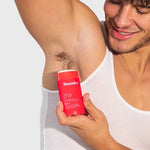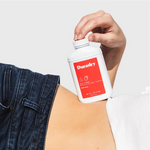Palmar hyperhidrosis, known as sweaty palms, occurs due to an exaggerated response of the sweat glands responsible for perspiration in this area. It´s the most common type of hyperhidrosis and is estimated to affect 3% of the population. Is more common in women than in men. The majority of sufferers have a genetic family history of the condition. It usually appears in childhood or puberty and can last a few years or remain for a lifetime.
Palmar hyperhidrosis has a significant impact on the quality of life of those who suffer it. It causes discomfort, interferes with daily activities and according to numerous studies, affects the emotional and psychological state.
People with hyperhidrosis usually have sweating even in winter or when the environment is cool. It is not only due to causes such as stress but it is a mismatch of the organism, so sweat can appear at any time without any trigger.
In the labor field, this is one of the most annoying ailments. Those who suffer from excessive sweat on the palms of their hands often feel embarrassed by not being able to shake hands with their colleagues. They may even present problems when working on the computer, with the mouse or with other electronic equipment.

But palmar hyperhidrosis has treatment and, in fact, when life becomes impossible it is necessary to undergo the best treatment according to your possibilities.
There are several ways to act on the condition, let's look at each of them.
Treatments for sweaty hands
1.Antiperspirants
One of the first-line treatments for palmar hyperhidrosis is the use of antiperspirants that block the ducts of the glands preventing sweat from being expelled. Antiperspirants act as astringents. They are applied on the hands and metal salts such as aluminum sulfate, and aluminum chloride or aluminum hydrochloride are usually used.
Antiperspirants are one of the most effective treatments with fewer side effects. It is also one of those that produces visible results quickly.
You can try Duradry to see results 3-7 days after you start the treatment.

2.Body Wipes
Based on the same principle as antiperspirants. Wet body wipes begin working immediately to effectively prevent sweat in the area where applied. Body wipes comes pre-soaked with the right amount of aluminium chloride, so the application is easy, convenient and with no mess.
Body wipes provide super strong yet safe and soothing effectiveness against sweating in a convenient and transportable format. Great for traveling, with no mess and no rubbing.

3.Butolinic toxin
Another widely used dermatological solution are botulinum toxin injections, or what is the same; Botox. These injections not only serve to eliminate wrinkles, Botox also eliminates excessive sweating. However, it is an expensive, painful treatment and its duration is only 6 or 8 months.

4.Iontophoresis
Iontophoresis consists of the application of ionized agents on the skin through an electric current that passes through the skin. The current causes a temporary rest of the glands. When these ions are absorbed, sweating gradually decreases in the area where the procedure was carried out. The treatment is performed every day, about 10 to 15 minutes, alternating later to biweekly or monthly sessions.
There is the option of performing this procedure at home, however it is recommended that you always be accompanied by a professional, as it can cause irritation, dryness and blistering of the skin. So it is important to always go to a specialized clinic for a complete evaluation and professional follow-up.
Iontophoresis is an effective treatment but it is not considered a definitive treatment and is not suitable for everyone. For example, pregnant women or people with pacemakers cannot do it. Neither can, those who have metal prostheses or women with IUDs (intrauterine device).

5. ETS Surgery
Surgery performed to control palmar hyperhidrosis is known as sympathectomy, in which the nerves that stimulate the sweat glands are cut, with the goal of stopping excessive sweat production. The procedure is performed by small incisions in the back. Right in the back area below the arm, the surgeon makes two or three tiny incisions. In this way the lung collapses and does´n let air in or out so that the surgeon can work better. Through one of the incisions the doctor will insert an endoscope (camera) to see the procedure and through the other two incisions, the necessary tools. What is intended to be achieved is to locate the nerves that control sweating to cut and eliminate them. Then the lung is re-inflated and the area is closed. The same thing will be repeated on the other side.
Despite the good results, sympathectomy can have as a side effect a compensatory hyperhidrosis, that is, excessive sweating in any part of the body where there was no excessive production In addition, it can have an opposite effect, in which the hands dry too much, being necessary the application of moisturizers. In this way, surgery is indicated in cases where hyperhidrosis cannot be combated with other treatments.

6. Oral Drugs
The use of drugs that have been shown to have a sweat-reducing effect are Glycopyrrolate and Oxybutynin, which are anticholinergics. These can be taken every day according to the doctor's prescription.Despite having good results, anticholinergic medications can produce side effects, such as dry mouth, difficulty urinating, or dizziness.

7. Antihydral (Methenamine)
Antihydral hasn´t FDA approval, but it has in Germany since 1996. It's prodrug is methenamine which sets free formaldehyde in acidic milieu. Formaldehyde reacts with proteins in sweat and blocks sweat glands temporarily.
Apply a very small amount of Antihydral to your hands before going to bed. The solution leaves a white residue; wash it off the next morning. Two or three treatments of Antihydral will leave your skin feeling drier and harder for days.
Indiscriminate use of Antihydral can lead to excessive dryness and yellowish skin. It is contraindicated for people allergic to formaldehyde. Formaldehyde itself is discussed to be cancerigen in direct high concentrations on mucosa.

Any of these treatments can be effective, as long as you are consistent and consult with your doctor which is the best option for your case.
All treatments have their defenders and detractors, it is up to you to try and find the treatment that fits your needs.



